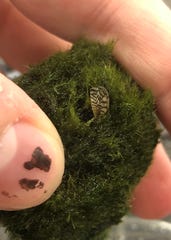Federal and state agencies are working with pet and aquarium stores across the U.S. to remove moss balls infected with zebra mussels. Here’s why.
Wochit
Until recently, moss balls were known as an ornamental product for aquariums that help generate oxygen and remove nitrates. But last week, federal officials found that a harmful invasive species had been hitch-hiking a ride on these fluffy green accessories.
As of Thursday, pet stores in more than 30 states found the invasive zebra mussel hidden among moss balls on their shelves. Reports of the aquatic pest have come from all across the country, from Alaska to Florida and New Mexico to Vermont.
These moss ball shipments have been coming from Ukraine, which is native habitat for zebra mussels, according to Wesley Daniel, a fisheries biologist with the U.S. Geological Survey. It is illegal to own, sell or distribute live zebra mussels in the U.S.
The USGS received the first reports during the last week of February and raised the alarm to other federal and state agencies, which have since sprung into action.
If you are an aquarium owner and have recently purchased a moss ball, here’s what you need to know about the potential risk and how to handle it.
Why are zebra mussels dangerous?
These mussels, native to Eurasia, first invaded the country in the 1990s through ballast water that was emptied into the Great Lakes. Since then, they’ve become an established nuisance in those lakes as well as in many inland water bodies in the Midwest region, hitching rides on the bottoms of boats and other aquatic gear. Indiana is no exception.
These mussels multiply quickly, without any natural predator, and cling in clumps to any solid object in the waters they inhabit. The tiny mollusks eat plankton and other algae that is the food source for native fish and insects. Those native species then struggle and it moves on up the chain, thoroughly disrupting the aquatic food web in the Great Lakes.
Invasive zebra mussels: More than 30 states, including Indiana, find them in aquarium moss balls
 Buy Photo
Buy Photo
Like a green carpet spreading out from an island, algae and other invasive water plants coat the surface of Geist Reservoir Wednesday September 18, 2013. The plants and zebra mussels have combined to make life difficult for boaters, fouling center boards of sailboats, wrapping around motorboat propellers, and fouling the intakes of jet skis. (Photo: Joe Vitti / The Star)
They have also been blamed for exacerbating the impact of harmful algal blooms, as they eat everything but the toxic blue-green algae. That allows the algae to spread to dangerous levels.
Not only do zebra mussels have serious impacts on recreation and tourism, but they have cost cities and industry millions of dollars. Zebra mussels love to cling to hard surfaces such as intake and outtake pipes, according to Indiana Department of Natural Resources, and companies and governments then have to constantly work, and spend, to keep them from getting clogged.
What is being done?
The USGS is working with the U.S Fish and Wildlife Service as well as state agencies and groups that represent the pet stores to make sure that all moss ball stocks are removed from the shelves. Those inventories are then being quarantined and will be decontaminated and disposed of using the recently-developed guidelines.
The big box stores, being Petco and PetSmart, are also reaching out to customers through their membership clubs and posting signs in their stores to try to reach those who have recently purchased moss balls, Daniel said.

This invasive zebra mussel was found at a Salem-area pet store. (Photo: COURTESY OF OREGON DEPARTMENT OF FISH AND WILDLIFE)
Infested-moss balls have also been found from online retailers and smaller, independent stores. Though more difficult to know the extent of the spread at that level, Daniel said they are working to get the message out to those stores and their customers.
About 30% of the inventories that have been pulled have been infested, Daniel said based on research in the last week.
The agencies were very unprepared for this particular type of pathway, Daniel said, as they have primarily focused on mussels being transported on boats and other aquatic gear. But this one poses a serious risk because of how diffuse it is, he added.
How to dispose of them?
Though the moss balls should be contained in aquariums, there still are concerns that the balls, and therefore the mussels, could be spread into the wild. This is a particular worry in areas and states that they have not infested yet, such as those out west.
Aquarium dumping, or disposing of unwanted pets and plants into natural waterways, occurs more than you’d think, according to Eric Fischer with Indiana’s DNR. The state often discovers aquarium species such as goldfish in Indiana’s waters. If the moss balls were to be released into a natural body of water or not disposed of properly, the zebra mussels could further spread, Fischer said.
Amid these concerns, Indiana DNR recommends that anyone who purchased moss balls from a pet or aquarium store this year to decontaminate and destroy the product — even if a zebra mussel is not clearly visible. The U.S. Fish and Wildlife Service, USGS and representatives of the pet industry have developed instructions for how to carefully decontaminate the moss balls and destroy any zebra mussels and larvae they contain.
The methods include:
- To freeze the moss ball for at least 24 hours;
- Place the moss balls in boiling water for at least one minute;
- Place the moss balls in diluted chlorine bleach;
- Or submerge the moss balls in undiluted white vinegar for at least 20 minutes.
After following one of these methods, bag the moss ball and dispose of it in the trash.
How to clean tank?
If you purchased a moss ball in recent months, especially if it’s one that you see a zebra mussel on, it’s also recommended that you clean your tank.
In order to do that and decontaminate the aquarium, you should remove the plants and pets from the tank and then add a tenth of a cup of bleach for every gallon of water in your tank. Make sure the bleach is mixed in and then allow the mixture to sit in the tank for at least 10 minutes.
Then drain the tank and make sure it’s well rinsed out before putting your pets and plants — sans moss ball — back into the tank.

Zebra Mussels. (Photo: Pennsylvania Fish & Boat Commission)
Who to contact?
If you spot a zebra mussel — identifiable by light and dark stripes on the fingernail-sized mollusks — on a moss ball that you’ve recently purchased, you should email [email protected] with the source of the moss balls, the approximate date of purchase, and photographs of zebra mussels on the moss balls.
You can also report a suspected sighting of a zebra mussel through the USGS database at https://nas.er.usgs.gov/SightingReport.aspx.
For more information on zebra mussels or other aquatic invasive species, see dnr.IN.gov/6348.htm.
Call IndyStar reporter Sarah Bowman at 317-444-6129 or email at [email protected]. Follow her on Twitter and Facebook: @IndyStarSarah. Connect with IndyStar’s environmental reporters: Join The Scrub on Facebook.
IndyStar’s environmental reporting project is made possible through the generous support of the nonprofit Nina Mason Pulliam Charitable Trust.
Read or Share this story: https://www.indystar.com/story/news/environment/2021/03/12/here-5-things-know-invasive-zebra-mussels-moss-balls/4652002001/

